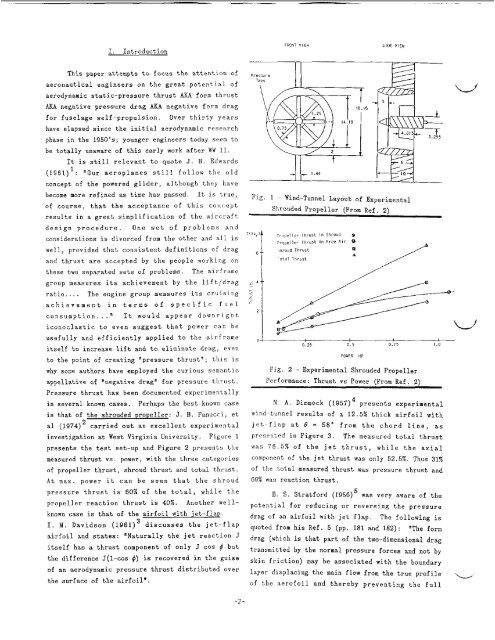Fuselage self-propulsion by static-pressure thrust - CAFE Foundation
Fuselage self-propulsion by static-pressure thrust - CAFE Foundation
Fuselage self-propulsion by static-pressure thrust - CAFE Foundation
You also want an ePaper? Increase the reach of your titles
YUMPU automatically turns print PDFs into web optimized ePapers that Google loves.
I. Introduction<br />
This paper attempts to focus the attention of<br />
aeronautical engineers on the great potential of<br />
aerodynamic <strong>static</strong>-<strong>pressure</strong> <strong>thrust</strong> AKA form <strong>thrust</strong><br />
AKA negative <strong>pressure</strong> drag AKA negative form drag<br />
for fuselage <strong>self</strong>-<strong>propulsion</strong>. Over thirty years<br />
have elapsed since the initial aerodynamic research<br />
phase in the 1950's; younger engineers today seem to<br />
be totally unaware of this early work after HW 11.<br />
It is still relevant to quote J. B. Edwards<br />
1<br />
(1961) : "Our aeroplanes still follow the old<br />
concept of the powered glider, although thcy have<br />
become more refined as time has passed. It is truc,<br />
of course, that the acceptance of this concept<br />
results in a great simplification of the aircraft<br />
design procedure. One set of problems and<br />
considerations is divorced from the other and all is<br />
well, provided that consistent definitions of drag<br />
and <strong>thrust</strong> are accepted <strong>by</strong> the people working on<br />
these two separated sets of problems. The airirame<br />
group measures its achievement <strong>by</strong> the lift/drag<br />
ratio .... The engine group measures its cruising<br />
achievement in terms of specific fuel<br />
consumption ..." It would appear downright<br />
iconoclastic to even suggest that power can be<br />
usefully and efficiently applied to the airframe<br />
it<strong>self</strong> to increase lift and to eliminate drag, even<br />
to the point of creating "<strong>pressure</strong> <strong>thrust</strong>"; this is<br />
why some authors have employed the curious semantic<br />
appellative of "negative drag" for <strong>pressure</strong> <strong>thrust</strong>.<br />
Pressure <strong>thrust</strong> has been documented experimentally<br />
in several known cases. Perhaps the best-known case<br />
is that of the shrouded Dropeller: .I. E. Fanucci, et<br />
a1 (1974)' carried out an excellent experimental<br />
investigation at West Virginia University. Figure 1<br />
presents the test set-up and Figure 2 presents the<br />
measured <strong>thrust</strong> vs. power, with the three categories<br />
of propeller <strong>thrust</strong>, shroud <strong>thrust</strong> and total <strong>thrust</strong>.<br />
At max. power it can be seen that the shroud<br />
<strong>pressure</strong> <strong>thrust</strong> is 60% of the total, while the<br />
propeller reaction <strong>thrust</strong> is 40%. Another well-<br />
known case is that of the airfoil with jet-flap.<br />
I. M. Davidson (1961)3 discusses the jet-flap<br />
airfoil and states: "Naturally the jet reaction J<br />
it<strong>self</strong> has a <strong>thrust</strong> component of only J cos $ but<br />
the difference J(1-cos #) is recovered in the guise<br />
of an aerodynamic <strong>pressure</strong> <strong>thrust</strong> distributed over<br />
the surface of the airfoil'.<br />
-2-<br />
Fig. 1 ~<br />
Wind-Tunnel<br />
Layout of Experimental<br />
Shrouded Propeller (From Ref. 2)<br />
c-----I<br />
0.25 0.5 0.75 1.0<br />
POWER HP<br />
Fig. 2 - Experimental Shrouded Propeller<br />
Performance: Thrust YS Power (From Ref. 21<br />
N A. Dimmock (1957) 4 presents experimental<br />
wind-tunnel results of a 12.5% thick airfoil with<br />
jet-flap at 0 = 58" from the chord line, as<br />
presented in Figure 3. The measured total <strong>thrust</strong><br />
was 76.5% of the jet <strong>thrust</strong>, while the axial<br />
component of the jet <strong>thrust</strong> was only 52.5%. Thus 31%<br />
of the total measured <strong>thrust</strong> was <strong>pressure</strong> <strong>thrust</strong> and<br />
69% was reaction <strong>thrust</strong>.<br />
B. S . Stratford (1956)5 was very aware of the<br />
potential for reducing or reversing the <strong>pressure</strong><br />
drag of an airfoil with jet flap. The following is<br />
quoted from his Ref. 5 (pp. 181 and 182): "The form<br />
drag (which is that part of the two-dimensional drag<br />
transmitted <strong>by</strong> the normal <strong>pressure</strong> forces and not <strong>by</strong><br />
skin friction) may be associated with the boundary<br />
layer displacing the main flow from the true profile<br />
of the aerofoil and there<strong>by</strong> preventing the full<br />
-

















